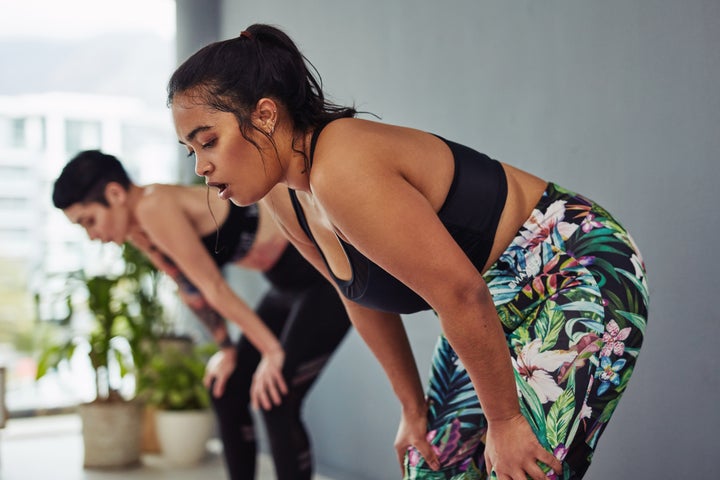The pressure to have a “good workout” can be intense thanks to fitness trackers and influencers on social media. As a result, many people define a good workout as exercise with lots of sweat and a super-high heart rate ― not a more moderate fitness regimen like walking or yoga. But that’s wrong.
Studies show that walking just 21 minutes a day can lower your risk of heart disease by 30%, while exercise like yoga can reduce chronic back pain and have huge benefits for your mental health.
In other words, that HIIT workout or mildly painful run may not actually be right for you — or even necessary, at least not for every workout. Experts shared what to know about low-intensity exercise and why it’s just as effective as high-intensity activity.
Hitting your maximum heart rate during every single workout is not necessary
When it comes to your heart rate, which most fitness trackers measure, “there is no need to hit your max heart rate in a workout,” said Andrew Jagim, the director of sports medicine research at Mayo Clinic Health System in Onalaska, Wisconsin, USA.
To calculate your maximum healthy heart rate, you can subtract your age from 220, Jagim said. So if you’re 45 years old, you would subtract 45 from 220 to get a maximum heart rate of 175 beats per minute.
Most peoples’ heart rates (including athletes) stay between 60% and 80% of their max during cardio exercise — and that’s perfectly OK, Jagim said. He added that people who are working out at their maximum heart rate or just below it (between 80% and 100%) should not task themselves with a long, grueling workout. Instead, training at this intensity should last for 15 to 20 minutes and should involve interval training.
Jagim said this could look like 30 seconds of max effort followed by one to two minutes of light recovery, with your heart rate at 50% to 60% of your max for 15 to 20 minutes after.
You don’t need to do an hour-long super-intense workout in this case: A shorter duration of time is actually recommended.
There are clear benefits to slower-paced workouts
While many high-intensity workouts depend on timed interval training — like the 30 seconds on, one-minute off method mentioned above — that is generally not the case with lower-intensity workouts, said RaGina McKissick, a certified personal trainer and group fitness instructor at Lumos Yoga & Barre in Philadelphia, USA.
Lower-intensity workouts include walking, barre, pilates and certain dance classes, McKissick said. These activities can be done at your own pace to ensure you reap all of the benefits of the exercise.
“You can take as long as you want, which means you can focus on the other things that are so important, like maximising the movement, full range of movement, mobility, flexibility, depth and strength,” she said.
Another benefit of low-intensity workouts is the ability to focus on and control your breathing, McKissick said. “A lot of times in high-intensity workouts, people don’t know how to breathe correctly and so they either fatigue really fast or they get light-headed or nauseous,” she added.
In slower-paced, low-intensity workouts, you can laser-focus on your breath and even use that breathwork to help you get through certain movements, she said.

Incorporating different kinds of movement allows you to cross-train
Adding low-intensity exercise into your fitness regimen allows you to cross-train, something that is common among professional and collegiate athletes, McKissick said.
“You give yourself the ability to challenge yourself in a different way,” she said.
Some folks who don’t do any kind of low-intensity exercise wonder why they aren’t getting the result they hoped for from a strictly cardio, high-intensity workout regimen, McKissick said.
She explained this is “because you aren’t fully allowing your muscles to get the benefit out of the exercises you’re doing when you’re always trying to go so fast and you’re only focused on cardio.”
It’s important to prioritise a workout you can sustain and will enjoy
It’s easy to obsess over your heart rate when it’s shown in huge numbers on your fitness tracker, but unless you’re doing a very specific kind of training, there is no need.
Reaching your max heart rate is only necessary for those trying to work on their maximum performance, according to the American College of Sports Medicine. For aerobic fitness, basic endurance and fat burn, you can stay within that 60% to 80% window.
“Don’t feel pressured to exercise at such a high intensity that the workout is painful or not enjoyable, as that will not be a predictor of long-term success,” Jagim said.
It’s important to listen to your body and do fitness regimens that you enjoy and that incorporate different kinds of fitness: strength training, cardio and low-intensity training, McKissick said. And if a certain trending workout isn’t working for you, that is OK, she said. It’s more important to find a regimen you like and stick to it.
“There’s a difference between challenging yourself and pushing yourself too far in regards to fitness,” McKissick said.
